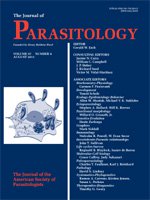Haemoproteus (Parahaemoproteus) micronuclearis n. sp., Haemoproteus (Parahaemoproteus) nucleofascialis n. sp., Haemoproteus (Parahaemoproteus) paranucleophilus n. sp., and Haemoproteus (Parahaemoproteus) homobelopolskyi n. sp. (Haemosporida, Haemoproteidae) are described from African passeriform birds based on the morphology of their blood stages and segments of the mitochondrial cytochrome b gene. Red-billed quelea (Quelea quelea), red-headed malimbe (Malimbus rubricollis), and black-headed weaver (Ploceus melanocephalus) are the type vertebrate hosts of new hemoproteids. It is probable that new species have wide distribution in weavers in sub-Saharan Africa. Both H. micronuclearis and H. nucleofascialis can be readily distinguished from other avian hemoproteids by tiny, compact microgametocyte nuclei that are significantly smaller than macrogametocyte nuclei and are a rare character of hemosporidian parasites. Gametocytes of H. paranucleophilus are closely appressed to the erythrocyte nuclei and do not touch the erythrocyte envelope along their entire margin at all stages of their development, including fully grown gametocytes. A particularly distinctive feature of H. homobelopolskyi development is the presence of circumnuclear dumbbell-shaped macrogametocytes. Illustrations of blood stages of the new species are given, and morphological and phylogenetic analyses identify the DNA lineages that are associated with these parasites. Numerous recent studies show that some lineages of hemoproteids are often present in birds belonging to different families. As a result, the use of the host family as a taxonomic character should be questioned and preferably discouraged in hemoproteid taxonomy, particularly with regard to the parasites of passerine birds. Microscopic identification of avian hemoproteids requires comparison of Haemoproteus species described from birds of different families, as is an established practice with avian Plasmodium spp. Development of bar-coding techniques remains essential in taxonomic and field studies of hemosporidian parasites.
How to translate text using browser tools
1 August 2011
New Avian Haemoproteus Species (Haemosporida: Haemoproteidae) From African Birds, with a Critique of the Use of Host Taxonomic Information in Hemoproteid Classification
Tatjana A. Iezhova,
Molly Dodge,
Ravinder N. M. Sehgal,
Thomas B. Smith,
Gediminas Valkiūnas
ACCESS THE FULL ARTICLE

Journal of Parasitology
Vol. 97 • No. 4
August 2011
Vol. 97 • No. 4
August 2011




